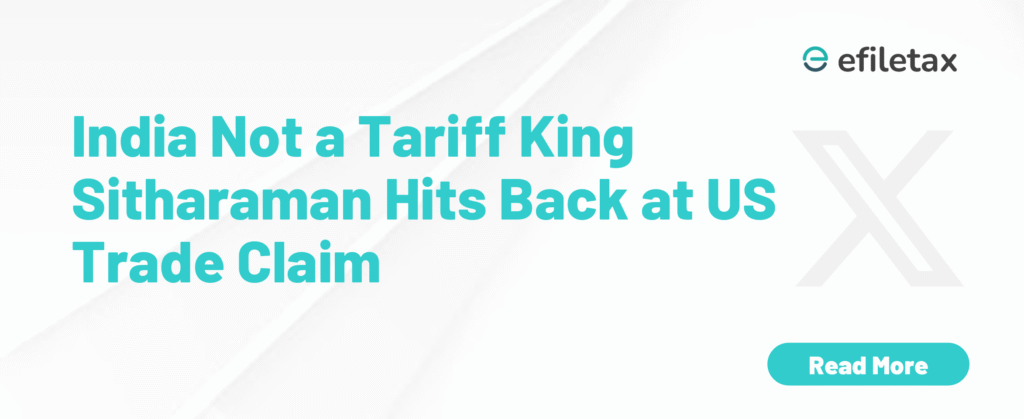
India Tariff King Claim FM Sets the Record Straight
India is not the “tariff king” the U.S. claims. In a recent statement, Finance Minister Nirmala Sitharaman clarified that while Parliament approves upper tariff limits, the actual import duties levied by India are far lower in most cases.
This clarification came in response to U.S. complaints that Indian tariffs are disproportionately high. But is that really true? Let’s break down the facts, legal structure, and policy direction — in simple terms.
Understanding India’s Tariff Structure
India’s import tariff regime is governed by:
- Customs Act, 1962
- Customs Tariff Act, 1975
- Finance Acts (Annual)
- WTO commitments and FTAs
Tariffs include:
- Basic Customs Duty (BCD)
- IGST on imports
- Social Welfare Surcharge
✅ Key Insight: Parliament may approve a high ceiling (say, 150%), but the actual BCD is often below 10% for many items.
What Did the Finance Minister Say?
FM Sitharaman countered the “tariff king” tag by stating:
🗣️ “Yes, our tariff schedule has high ceilings approved by Parliament. But in practice, the applied rates are far lower.”
She added that:
- India is negotiating free trade agreements (FTAs) with multiple countries
- Tariff simplification is already underway
- The aim is to boost exports and manufacturing under Make in India
India vs U.S.: A Quick Comparison
| Metric | India | U.S. |
|---|---|---|
| Avg. Applied Tariff (WTO 2023) | ~13% (MFN) | ~3.4% |
| Bound Tariff Ceiling | Up to 150% | Mostly < 50% |
| FTA Participation | 13+ signed, more in pipeline | 20+ |
| Non-Tariff Barriers | Moderate | High (e.g., standards, tech rules) |
📌 Expert View: “Tariff policy must be seen along with non-tariff practices. The U.S. uses tech and legal standards as trade barriers,” says a trade economist at IIFT.
Why Are India’s Tariffs Structured This Way?
- Policy Flexibility: Higher ceilings give the government room to adjust duties during emergencies (e.g., wheat export ban, COVID gear import relief)
- Revenue Mobilisation: Import duties still contribute ~15% of total revenue
- Domestic Industry Support: Sectors like textiles, electronics, and dairy need tariff protection against cheap imports
Recent Moves by India to Cut Tariffs
- Mobile phone parts: Gradual phase-out of duty under PLI Scheme
- Electric vehicles: Concessions for EVs with local manufacturing
- Apple, Tesla, others: Invited to set up in India with lower duty incentives
🔗 Read: Budget 2024–25 Customs Highlights – efiletax.in
India’s Trade Agreements: A Proactive Push
India has recently signed or is negotiating deals with:
- UAE (CEPA) – Already in effect
- Australia (ECTA) – Signed and operational
- EU, UK, Canada – Under negotiation
💡 Goal: Use FTAs to access markets while maintaining strategic duties on sensitive goods
Summary
India is not the tariff king. FM Sitharaman clarified that while Parliament sets high tariff limits, actual applied rates are much lower. India is simplifying duties, signing FTAs, and promoting exports—not blocking trade.
FAQs
Q1. Why does India have high tariff ceilings in law?
To allow flexibility during price shocks, trade wars, or emergencies. Applied rates are often much lower.
Q2. Are Indian tariffs higher than global averages?
Yes, but with context. Many countries use non-tariff barriers instead. India uses tariffs for revenue and to protect jobs.
Q3. Will tariffs come down in the future?
Yes, under FTAs and PLI schemes, India is gradually lowering duties on select goods.
Final Thoughts
India’s trade policy balances global competitiveness with local needs. The “tariff king” tag oversimplifies a complex, evolving system.